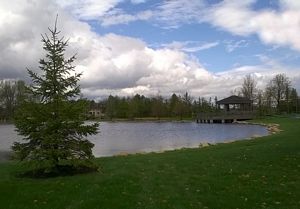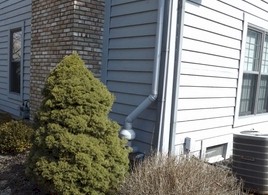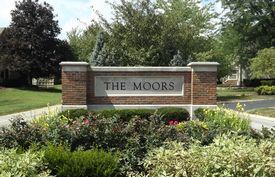Home Page :: About Muirfield Village :: For Real Estate Agents :: What Future Owners Should Know
WHAT FUTURE OWNERS SHOULD KNOW
 Many home owners have chosen Muirfield Village
because of continued high property values and the quality of life.
Muirfield is able to remain a desirable community because of
its standards, which govern construction and property care.
Many home owners have chosen Muirfield Village
because of continued high property values and the quality of life.
Muirfield is able to remain a desirable community because of
its standards, which govern construction and property care.
Many future residents may wish to make Muirfield their home because of the assurance that exterior property care is mandatory and that homes and properties must meet design standards. However, some buyers would be happier in a community where they are not restricted in any way. This page highlights important topics a potential resident should know when choosing to move to Muirfield Village.
Real Estate agents, buyers and sellers should be aware that if a radon mitigation unit must be installed as a condition of sale, the location must be approved before installation. Read more about Radon Units below.
- Muirfield Village is a Planned Unit Development
- Approval Required for All Exterior Property Changes, Removals and Additions
- Radon Unit Approval Necessary
- Deed Violations Are Attached to Properties
- Requesting Property Changes Before Purchase
- Annual Assessment
- About Sub-Associations
Muirfield Village is a Planned Unit Development
Muirfield Village is a Planned Unit Development. There are standards that govern all construction and renovations plus what is permitted to occur on the exterior of the home and property. These standards come from the Declaration (Warranty Deed) plus Design Standards found in Property Policies and the Resident Handbook.
There is an HOA (Homeowners Association), which is Muirfield Association, Inc. One of the duties of the HOA is to enforce community standards.
Potential owners may wish to review the Declaration (Warranty Deed - in particular, Article 8), Property Policies, and the Resident Handbook to understand Muirfield Village rules and regulations before committing to purchase.
Approval Required for Exterior Property Changes
All plans for exterior property changes, additions, and/or removals must be reviewed and approved by the Design Control Committee before any work begins. (Muirfield Association does not regulate what changes occur on the interior of a house.) Some examples include, but are not limited to:
- Home additions, new garages, and storage buildings;
- All play equipment such as basketball units, trampolines, swing sets, sports nets and other recreation equipment;
- Radon unit installation (read more below);
- Decks, patios, porches, sun rooms, hot tubs, spas and pools;
- Driveways and walkways;
- Fencing (which is extremely limited in Muirfield Village);
- Doors and garage doors;
- Windows (whether replacing one or all);
- Roof replacements (partial replacements or patching is not permitted);
- Landscaping changes such as adding/removing trees, bushes, shrubs, perennials, and gardens;
- Exterior paint colors
There are also requirements for the quality of materials used in construction, exterior renovations, and on properties. Guidelines and applications for nearly every project can be found in the Design Review section.
Essentially, approval is required for anything that occurs on the exterior of the home or on the property. However, residents do not need approval to:
- Make interior changes of any kind to their home.
- Add an invisible fence. No signage or advertisements are permitted on the property or mailbox. It is prohibited to install invisible fencing in an easement area or City right-of-way.
- Plant annual flowers in existing beds. The creation of new beds requires approval.
- Repaint or restain the home, trim, or exterior accessory the exact same color. The Association strongly recommends residents contact the office to ensure that the color they are repainting/restaining with has already been approved and is on file with the office.
- Replace rotted siding or deck boards with the exact same material. For example, rotten wood boards on a deck can be replaced with wood. However, if an owner wishes to replace wood with a composite or other material, approval is required.
- Place a "For Sale" sign on the property. However, there are specific signage requirements. Read sign policies here.
 Frequently, a home will have a radon inspection before being sold.
If a seller is required to add a radon mitigation unit,
its location and screening must be approved by the Design Control Committee
before the unit is installed.
Frequently, a home will have a radon inspection before being sold.
If a seller is required to add a radon mitigation unit,
its location and screening must be approved by the Design Control Committee
before the unit is installed.
The Design Control Committee will consider the following in order to grant approval:
- The radon unit must be mounted at the rear elevation or side rear elevation of the house, tucked up close to the house in an inconspicuous spot.
- Adequate evergreen shrubbery (at least 36” in height) must be planted and maintained to screen the exterior motor from view year-around.
- All exterior portions of the radon unit must be painted the color of the house adjacent to the unit.
- The radon unit release pipe must terminate no more than 18” above the roofline and lower than the ridgeline of the house.
Potential owners should be aware that if the current owner does not obtain approval to install the unit, the property will be in violation and the new owner will need to correct the situation in order to clear the violation. Please read more below about how property violations are attached to the property itself as opposed to an owner.
The Design Control Committee will review the Radon Mitigation Plan at their next meeting. Meetings are listed on the Calendar. If time is of extreme essence, please contact the office at 614-889-0922.
Radon unit guidelines and the application may be found here:
Deed Violations Are Attached to Properties
When choosing a new home in any community, buyers generally want to learn about any potential problems beforehand. If a home has problems such as mold, water leakage, or insects, the buyer will inherit the problems if they are not corrected by the seller.
 Similarly, it is very important to understand that
a new owner of a home in Muirfield Village
will inherit any uncorrected violations of the Warranty Deed and Design Standards
and will be required to remedy the situation in order to bring the property into compliance.
Similarly, it is very important to understand that
a new owner of a home in Muirfield Village
will inherit any uncorrected violations of the Warranty Deed and Design Standards
and will be required to remedy the situation in order to bring the property into compliance.
Per Article 8 of the Warranty Deed, opening paragraph, property violations are attached to the property itself. They are not attached to the owner. A property will not cease to have violations simply because it is transferred to a new owner. If violations are not corrected before the property transfers ownership, the new owner will be responsible for correcting them.
One possible example is a radon unit that was installed without approval. If the installation was not approved by the Design Control Committee and the unit is discovered by the Association, the new owner would be required to submit a proposal for the location of the unit and will likely need to paint the unit and/or plant evergreens to screen the motor.
Another example is dead or dying trees. The Emerald Ash Borer has decimated ash trees in this area. Dead or dying trees must be removed to prevent a violation, not to mention potential property damage. If dead or dying trees (or stumps) are not removed by the current owner, the responsibility and cost of removal and replacement of the tree will fall on the new owner.
These instances are only two examples. Any and all property violations are attached to the property itself and will become the responsibility of the new owner to correct.
Correcting inherited violations may take time and money plus cause distress for new owners. With this in mind:
- Potential buyers may wish to ask the current owner questions about the current status of the property and if there are any outstanding violations.
- Potential buyers should familiarize themselves with the Declaration (Warranty Deed), Property Policies, and the Resident Handbook in order to understand what may constitute a violation.
Requesting Property Changes Before Purchase
Sometimes, potential residents will only want to move to Muirfield if they will be permitted to install elements, such as a pool or recreation equipment, or make other changes to the property, such as removing trees and landscaping or adding a house addition.
The Design Control Committee can only grant approval for any change to the current owner of the property. Therefore, the current owner will need to submit a preliminary plan for the change the potential resident would like to make. There is no cost to submit a preliminary plan.
Read more and get directions for submitting a preliminary plan here.
By purchasing a property in Muirfield Village, an owner becomes a member of Muirfield Association. This is a mandated association. For the purpose of providing funds to operate the Association and to make capital improvements, the Board of Directors abides by Article 2 of the Warranty Deed to collect an annual assessment.
In the history of Muirfield Association, Inc., there has never been a need to call for a special assessment. The reserves are adequate and the Board of Directors has been fiscally responsible when working with capital expenditures and operating budgets.
Here's what future owners should know about the assessment:
- The annual assessment rate is $2.30 per $1,000 of the fair market value of the property as determined on or about January 1 of each year by the County Auditor. The formula listed below will help figure out the amount. Real estate agents may also call the office and ask the amount.
- Because the annual assessment is based on the auditor's current valuation of the property and because the auditor re-assesses properties every three years, the annual assessment amount may go up or down if the auditor assigns a different fair market value to the property.
- The assessment is billed one year in arrears, similar to property taxes. For example, the annual assessment for 2017 will be billed in 2018.
- The assessment is billed annually. The invoice is usually sent in late January. Invoices will arrive either in the mail or by email, depending on the method of delivery the resident chooses. Residents have 30 days to pay the balance.
- The seller must pay their proportionate share of the current year's assessment through the date of closing. This amount will be listed on the settlement statement. The buyer will be billed the following January for the unpaid balance (unless the title company, by their choice, bills the buyer at the time of closing).
- There are two gated communities that have additional biannual assessments. The rate fluctuates based on actual cost. Please contact the Association for more information
- Some properties are part of sub-associations which have their own additional fees. Read more below.
Take the fair market value as placed on the property by the county auditor and multiply it times .0023 to get the annual assessment.
 The Declaration governs all properties in Muirfield Village.
However, some Muirfield neighborhoods have additional architectural and
maintenance restrictions that are enforced by separate sub-associations.
The Declaration governs all properties in Muirfield Village.
However, some Muirfield neighborhoods have additional architectural and
maintenance restrictions that are enforced by separate sub-associations.
Sub-associations may charge additional fees that are entirely separate from the annual assessment. Each sub-association sets the fee amount, the frequency (for example, billed quarterly or yearly), and what the fee covers.
For information regarding fees, property restrictions, or maintenance performance in a sub-association, visit the Sub-Associations page and contact the appropriate neighborhood representative and/or property maintenance agency.
If in doubt whether a property is part of a sub-association or not, please feel free to contact the office.

